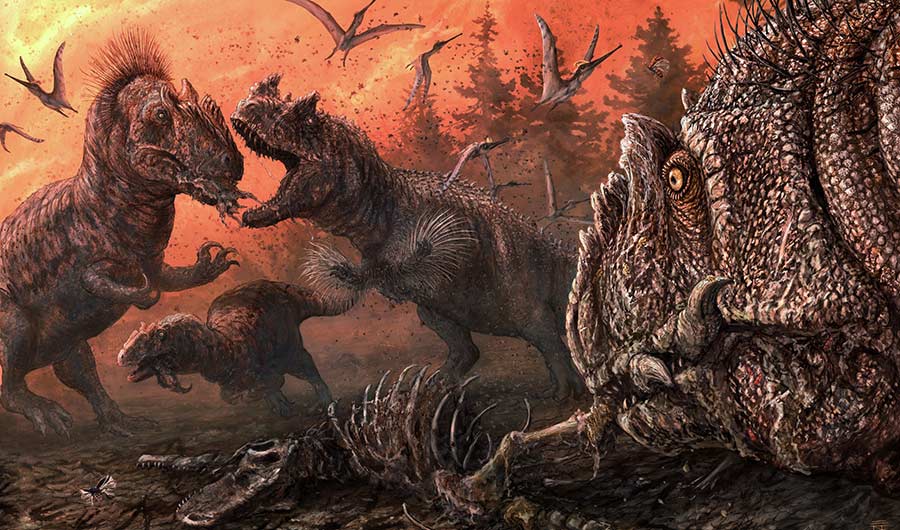Fossil Bite Marks Show Some Dinosaurs Ate Their Own
(Inside Science) -- Some 152 million years ago, the Mygatt-Moore Quarry that now sits in present day western Colorado was as good a place to die as any for a dinosaur. Whether the creatures whose remains litter the site were killed by predators or died of old age or sickness is unclear, but we now know that many of the dinos that breathed their last breath at Mygatt-Moore were eaten. Some were likely even cannibalized.
“It would take a while for these things to be buried,” said Stephanie Drumheller-Horton, a paleontologist at the University of Tennessee, in Knoxville. “There were an awful lot of jokes about what this place smelled like.”
The fossil bones at the quarry mostly belong to massive plant-eating sauropods and carnivorous theropods that lived during the Jurassic period. The most common species found is Allosaurus fragilis, a prehistoric predator around 30 feet long with powerful arms and large claws and teeth that likely roamed in herds.
Most paleontologists and fossil hunters focus on the beautiful intact remains that have survived the eons. But many of the famous dinosaur deposits around the world are also filled with a number of oft-overlooked fossilized bone fragments. Drumheller-Horton and her colleagues were keen to take a closer look at this “bunch of ugly, beat-up fossils, which are my favorite kind in the whole world,” she said.
While the intact skeletons of whole dinosaurs steal the show in museums or on science documentaries, they usually reveal little about ancient ecology. Most of these dinosaurs died as victims of natural disasters such as mudslides that quickly buried them, leaving their remains relatively pristine. Unless smaller fossilized bones representing a last meal are preserved in one animal's stomach, it’s difficult to say what they ate, or what ate them. Meanwhile, studying broken bones with bite marks, as Drumheller-Horton and her co-authors did in a study published today in the journal PLOS ONE, can tell us more about who was eating whom.
“This kind of study can get us a lot of information about what the environment was like, how these animals were living, how they were dying, how nutrients cycled through these environments,” Drumheller-Horton said.
The paleontologists analyzed 2,368 vertebrate fossils collected over decades of excavations from Mygatt-Moore. The fossils were found in the Morrison Formation, a layer of sedimentary rock from the Upper Jurassic that has proved one of the richest sources of dino fossils in North America. Of the thousands examined, 684 had bite marks -- some 28.9 percent.
“We just started finding literally hundreds of bite marks, which is a bit of a surprise to us,” Drumheller-Horton said, adding that due to the paucity of this type of evidence in fossils, some researchers had assumed that dinosaurs were more like modern day Komodo dragons, which often target soft tissues and leave bones alone.
To better understand the bite marks they found, the team classified them into dents, punctures, scores and other types.
It’s difficult to tell what creatures were responsible for many of the bites. But a number of the marks indicated they were made from striated, saw-like teeth that matched the size of the teeth of the two largest predators known from the area, Allosaurus and Ceratosaurus. The researchers even found the marks of a “substantially larger” predator that could have been either an uncharacteristically large Allosaurus or something usually found in other Morrison Formation fossil assemblages, such as Saurophaganax or Torvosaurus.
They found that sauropods represented 70% of the remains with bite marks, while therapods like Allosaurus represented 17%. Many of the latter were also found with bite marks that had striations, making it likely that they were cannibalizing their own species.
“To the best of our knowledge, this is the best evidence for it in Allosaurus,” Drumheller-Horton said, adding that cannibalism is relatively common in many modern predators as well.
Drumheller-Horton and her colleagues believe that the high number of bite marks on bones may show the area experienced droughts or other trying times that made bone-gnawing more common. But they are also careful to say that the quantity of bite marks may not be abnormal -- it could be just that most paleontologists don’t focus on these types of remains.
Gregory Erickson, a dinosaur paleobiologist at Florida State University in Tallahassee who was not involved in Drumheller-Horton’s study, likes the way the research was conducted, calling it “well-balanced.” Andre Rowe, a Ph.D. candidate in paleontology at the University of Bristol in the U.K., who was also not involved in the recent study, said more of these types of investigations should be done.
“There’s all kinds of tiny clues in the rocks that people tend to gloss over in favor of the big attractive bones,” Rowe said.
Drumheller-Horton said the team still can’t tell whether the dinosaurs died from the bites or whether their bodies were just scavenged, but she said both were probably occurring. She envisions that carcasses at the site would attract a succession of scavengers similar to what would happen with lions, hyenas and vultures in the modern-day African savanna. Deaths may have even occurred while two Allosaurus were fighting over prey, with the losing side subsequently getting eaten itself.
Rowe said the study adds to evidence that categorizing dinosaurs by their eating habits isn’t always the easiest.
He said most predators, extinct and living today, often use a mixture of hunting and scavenging.
Erickson agrees. “Most carnivorous animals are lazy. If it’s dead and it’s made out of meat, then let’s eat,” he joked.


